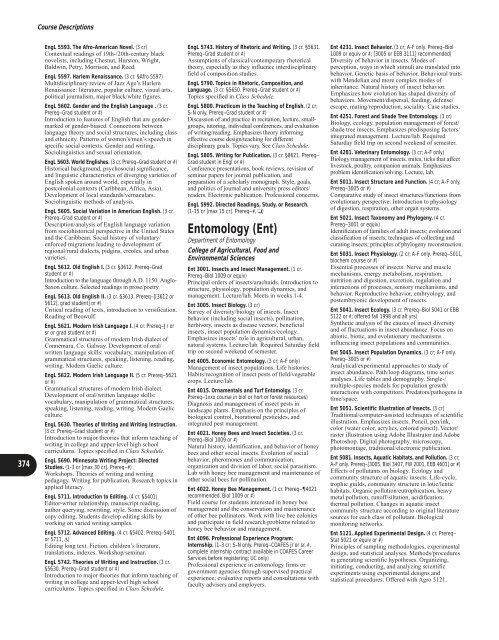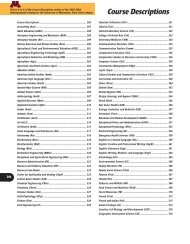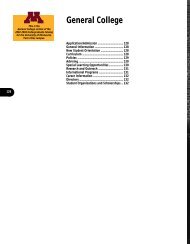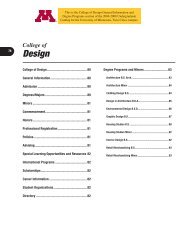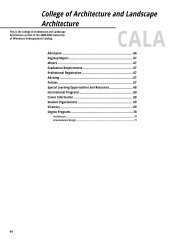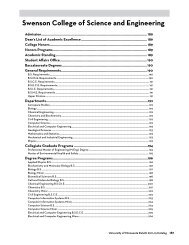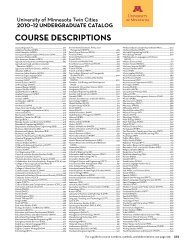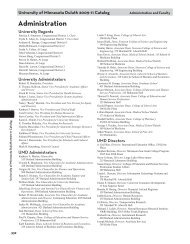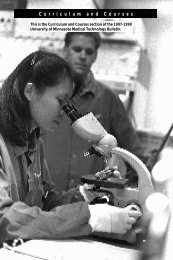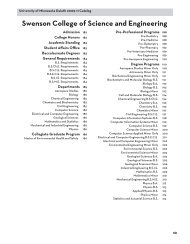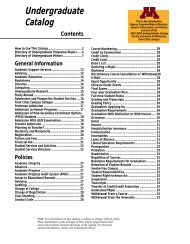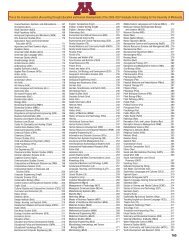CoursesâCSCI through FSCN - University Catalogs - University of ...
CoursesâCSCI through FSCN - University Catalogs - University of ...
CoursesâCSCI through FSCN - University Catalogs - University of ...
Create successful ePaper yourself
Turn your PDF publications into a flip-book with our unique Google optimized e-Paper software.
Course Descriptions374EngL 5593. The Afro-American Novel. (3 cr)Contextual readings <strong>of</strong> 19th-/20th-century blacknovelists, including Chesnut, Hurston, Wright,Baldwin, Petry, Morrison, and Reed.EngL 5597. Harlem Renaissance. (3 cr. §Afro 5597)Multidisciplinary review <strong>of</strong> Jazz Age’s HarlemRenaissance: literature, popular culture, visual arts,political journalism, major black/white figures.EngL 5602. Gender and the English Language . (3 cr.Prereq–Grad student or #)Introduction to features <strong>of</strong> English that are gendermarkedor gender-biased. Connections betweenlanguage theory and social structures, including classand ethnicity. Patterns <strong>of</strong> women’s/men’s speech inspecific social contexts. Gender and writing.Sociolinguistics and sexual orientation.EngL 5603. World Englishes. (3 cr. Prereq–Grad student or #)Historical background, psychosocial significance,and linguistic characteristics <strong>of</strong> diverging varieties <strong>of</strong>English spoken around world, especially inpostcolonial contexts (Caribbean, Africa, Asia).Development <strong>of</strong> local standards/vernaculars.Sociolinguistic methods <strong>of</strong> analysis.EngL 5605. Social Variation in American English. (3 cr.Prereq–Grad student or #)Description/analysis <strong>of</strong> English language variationfrom sociohistorical perspective in the United Statesand the Caribbean. Social history <strong>of</strong> voluntary/enforced migrations leading to development <strong>of</strong>regional/rural dialects, pidgins, creoles, and urbanvarieties.EngL 5612. Old English I. (3 cr. §3612. Prereq–Gradstudent or #)Introduction to the language <strong>through</strong> A.D. 1150. Anglo-Saxon culture. Selected readings in prose/poetry.EngL 5613. Old English II. (3 cr. §3613. Prereq–[[3612 or5612], grad student] or #)Critical reading <strong>of</strong> texts, introduction to versification.Reading <strong>of</strong> Beowulf.EngL 5621. Modern Irish Language I. (4 cr. Prereq–Jr orsr or grad student or #)Grammatical structures <strong>of</strong> modern Irish dialect <strong>of</strong>Connemara, Co. Galway. Development <strong>of</strong> oral/written language skills: vocabulary, manipulation <strong>of</strong>grammatical structures, speaking, listening, reading,writing. Modern Gaelic culture.EngL 5622. Modern Irish Language II. (5 cr. Prereq–5621or #)Grammatical structures <strong>of</strong> modern Irish dialect.Development <strong>of</strong> oral/written language skills:vocabulary, manipulation <strong>of</strong> grammatical structures,speaking, listening, reading, writing. Modern Gaelicculture.EngL 5630. Theories <strong>of</strong> Writing and Writing Instruction.(3 cr. Prereq–Grad student or #)Introduction to major theories that inform teaching <strong>of</strong>writing in college and upper-level high schoolcurriculums. Topics specified in Class Schedule.EngL 5690. Minnesota Writing Project: DirectedStudies. (1-3 cr [max 30 cr]. Prereq–#)Workshops. Theories <strong>of</strong> writing and writingpedagogy. Writing for publication. Research topics inapplied literacy.EngL 5711. Introduction to Editing. (4 cr. §5401)Editor-writer relationship, manuscript reading,author querying, rewriting, style. Some discussion <strong>of</strong>copy editing. Students develop editing skills byworking on varied writing samples.EngL 5712. Advanced Editing. (4 cr. §5402. Prereq–5401or 5711, ∆)Editing long text. Fiction, children’s literature,translations, indexes. Workshop/seminar.EngL 5742. Theories <strong>of</strong> Writing and Instruction. (3 cr.§5630. Prereq–Grad student or #)Introduction to major theories that inform teaching <strong>of</strong>writing in college and upper-level high schoolcurriculums. Topics specified in Class Schedule.EngL 5743. History <strong>of</strong> Rhetoric and Writing. (3 cr. §5631.Prereq–Grad student or #)Assumptions <strong>of</strong> classical/contemporary rhetoricaltheory, especially as they influence interdisciplinaryfield <strong>of</strong> composition studies.EngL 5790. Topics in Rhetoric, Composition, andLanguage. (3 cr. §5650. Prereq–Grad student or #)Topics specified in Class Schedule.EngL 5800. Practicum in the Teaching <strong>of</strong> English. (2 cr;S-N only. Prereq–Grad student or #)Discussion <strong>of</strong> and practice in recitation, lecture, smallgroups,tutoring, individual conferences, and evaluation<strong>of</strong> writing/reading. Emphasizes theory informingeffective course design/teaching for differentdisciplinary goals. Topics vary. See Class Schedule.EngL 5805. Writing for Publication. (3 cr. §8621. Prereq–Grad student in Engl or #)Conference presentations, book reviews, revision <strong>of</strong>seminar papers for journal publication, andpreparation <strong>of</strong> a scholarly monograph. Style, goals,and politics <strong>of</strong> journal and university press editors/readers. Electronic publication. Pr<strong>of</strong>essional concerns.EngL 5992. Directed Readings, Study, or Research.(1-15 cr [max 15 cr]. Prereq–#, ❏)Entomology (Ent)Department <strong>of</strong> EntomologyCollege <strong>of</strong> Agricultural, Food andEnvironmental SciencesEnt 3001. Insects and Insect Management. (1 cr.Prereq–Biol 1009 or equiv)Principal orders <strong>of</strong> insects/arachnids. Introduction tostructure, physiology, population dynamics, andmanagement. Lecture/lab. Meets in weeks 1-4.Ent 3005. Insect Biology. (3 cr)Survey <strong>of</strong> diversity/biology <strong>of</strong> insects. Insectbehavior (including social insects), pollination,herbivory, insects as disease vectors, beneficialinsects, insect population dynamics/ecology.Emphasizes insects’ role in agricultural, urban,natural systems. Lecture/lab. Required Saturday fieldtrip on second weekend <strong>of</strong> semester.Ent 4005. Economic Entomology. (3 cr; A-F only)Management <strong>of</strong> insect populations. Life histories.Habits/recognition <strong>of</strong> insect pests <strong>of</strong> field/vegetablecrops. Lecture/lab.Ent 4015. Ornamentals and Turf Entomolgy. (3 cr.Prereq–1xxx course in biol or hort or forest resources)Diagnosis and management <strong>of</strong> insect pests inlandscape plants. Emphasis on the principles <strong>of</strong>biological control, biorational pesticides, andintegrated pest management.Ent 4021. Honey Bees and Insect Societies. (3 cr.Prereq–Biol 1009 or #)Natural history, identification, and behavior <strong>of</strong> honeybees and other social insects. Evolution <strong>of</strong> socialbehavior, pheromones and communication,organization and division <strong>of</strong> labor, social parasitism.Lab with honey bee management and maintenance <strong>of</strong>other social bees for pollination.Ent 4022. Honey Bee Management. (1 cr. Prereq–4021recommended, Biol 1009 or #)Field course for students interested in honey beemanagement and the conservation and maintenance<strong>of</strong> other bee pollinators. Work with live bee coloniesand participate in field research problems related tohoney bee behavior and management.Ent 4096. Pr<strong>of</strong>essional Experience Program:Internship. (1-3 cr; S-N only. Prereq–COAFES jr or sr, #,complete internship contract available in COAFES CareerServices before registering; UC only)Pr<strong>of</strong>essional experience in entomology firms orgovernment agencies <strong>through</strong> supervised practicalexperience; evaluative reports and consultations withfaculty advisers and employers.Ent 4231. Insect Behavior. (3 cr; A-F only. Prereq–Biol1009 or equiv or #; [3005 or EEB 3111] recommended)Diversity <strong>of</strong> behavior in insects. Modes <strong>of</strong>perception, ways in which stimuli are translated intobehavior. Genetic basis <strong>of</strong> behavior. Behavioral traitswith Mendelian and more complex modes <strong>of</strong>inheritance. Natural history <strong>of</strong> insect behavior.Emphasizes how evolution has shaped diversity <strong>of</strong>behaviors. Movement/dispersal, feeding, defense/escape, mating/reproduction, sociality. Case studies.Ent 4251. Forest and Shade Tree Entomology. (3 cr)Biology, ecology, population management <strong>of</strong> forest/shade tree insects. Emphasizes predisposing factors/integrated management. Lecture/lab. RequiredSaturday field trip on second weekend <strong>of</strong> semester.Ent 4281. Veterinary Entomology. (3 cr; A-F only)Biology/management <strong>of</strong> insects, mites, ticks that affectlivestock, poultry, companion animals. Emphasizesproblem identification/solving. Lecture, lab.Ent 5011. Insect Structure and Function. (4 cr; A-F only.Prereq–3005 or #)Comparative study <strong>of</strong> insect structures/functions fromevolutionary perspective. Introduction to physiology<strong>of</strong> digestion, respiration, other organ systems.Ent 5021. Insect Taxonomy and Phylogeny. (4 cr.Prereq–3001 or equiv)Identification <strong>of</strong> families <strong>of</strong> adult insects; evolution andclassification <strong>of</strong> insects; techniques <strong>of</strong> collecting andcurating insects; principles <strong>of</strong> phylogeny reconstruction.Ent 5031. Insect Physiology. (2 cr; A-F only. Prereq–5011,biochem course or #)Essential processes <strong>of</strong> insects. Nerve and musclemechanisms, energy metabolism, respiration,nutrition and digestion, excretion, regulation andinteractions <strong>of</strong> processes, sensory mechanisms, andbehavior. Reproductive behavior, embryology, andpostembryonic development <strong>of</strong> insects.Ent 5041. Insect Ecology. (3 cr. Prereq–Biol 5041 or EBB5122 or #; <strong>of</strong>fered fall 1998 and alt yrs)Synthetic analysis <strong>of</strong> the causes <strong>of</strong> insect diversityand <strong>of</strong> fluctuations in insect abundance. Focus onabiotic, biotic, and evolutionary mechanismsinfluencing insect populations and communities.Ent 5045. Insect Population Dynamics. (3 cr; A-F only.Prereq–3005 or #)Analytical/experimental approaches to study <strong>of</strong>insect abundance. Path/loop diagrams, time seriesanalyses. Life tables and demography. Single-/multiple-species models for population growth/interactions with competitors. Predators/pathogens intime/space.Ent 5051. Scientific Illustration <strong>of</strong> Insects. (3 cr)Traditional/computer-assisted techniques <strong>of</strong> scientificillustration. Emphasizes insects. Pencil, pen/ink,color (water color, acrylics, colored pencil). Vector/raster illustration using Adobe Illustrator and AdobePhotoshop. Digital photography, microscopy,photomontage, traditional/electronic publication.Ent 5081. Insects, Aquatic Habitats, and Pollution. (3 cr;A-F only. Prereq–[3005, Biol 3407, FW 2001, EEB 4601] or #)Effects <strong>of</strong> pollutants on biology. Ecology andcommunity structure <strong>of</strong> aquatic insects. Life-cycle,trophic guilds, community structure in lotic/lentichabitats. Organic pollution/eutrophication, heavymetal pollution, run<strong>of</strong>f/siltation, acidification,thermal pollution. Changes in aquatic insectcommunity structure according to original literaturesources for each class <strong>of</strong> pollutant. Biologicalmonitoring networks.Ent 5121. Applied Experimental Design. (4 cr. Prereq–Stat 5021 or equiv or #)Principles <strong>of</strong> sampling methodologies, experimentaldesign, and statistical analyses. Methods/proceduresin generating scientific hypotheses. Organizing,initiating, conducting, and analyzing scientificexperiments using experimental designs andstatistical procedures. Offered with Agro 5121.


